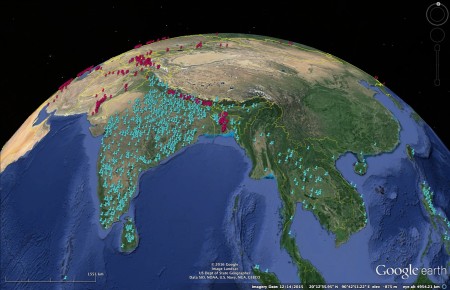- The impact of whole genome sequence data to prioritise animals for genetic diversity conservation. Relationships from whole genome sequence data were better than SNPs at preserving rare variants when selecting individuals for inclusion in a genebank.
- Genetic variation in wild populations of the tuber crop Amorphophallus konjac (Araceae) in central China as revealed by AFLP markers. Diverse, endangered, somewhat isolated populations, with some geographic structuring.
- Manihot allemii sp. nov. (Euphorbiaceae s.s.) with entire and unlobed leaves from northern Brazil, with notes about foliar anatomy. It never ends.
- Novel Genetic Resources in the Genus Vigna Unveiled from Gene Bank Accessions. Japan sorts out its genebank. It really does never end.
- Uncoupling of sodium and chloride to assist breeding for salinity tolerance in crops. We’ve been breeding for exclusion of Na+, but we should be breeding for tolerance to it.
- How can higher-yield farming help to spare nature? By making sure that lower prices and/or higher profits don’t encourage agricultural expansion.
- Seed exchange networks, ethnicity, and sorghum diversity. Culture drives diversity.
Scylla, meet Charybdis
It is much more expensive to produce many diverse locally adapted varieties, and more time-consuming. So big seed companies generally narrow their focus to reduce costs. The more the seed and breeding industries and communities become concentrated in a few mega-companies, the more these harmful trends will be exacerbated. But we’re reducing our adaptability just at the moment when we will need it the most.
Yeah, well, ok, sure. But then there’s foundations. Right? Well…
For the foundations, it appears, the profitability of small farms remains more important than the amount of food they produce.
Ok, but how about public research sector?
Another global organisation over which the BMGF appears to exert strong influence is the Consultative Group on International Agricultural Research (CGIAR), a consortium of 15 research centres which is the world’s most influential network for agricultural research in developing countries.
What’s a poor farmer to do?
Nibbles: Value edition
- Peru to give value to its biodiversity.
- Germany already has, 500 years ago.
- Cavendish bananas have a lot of value, but that won’t save them.
- The UK’s vegetables genebank is very valuable.
- But you can always add more value to genebank collections if you evaluate them, like IRRI’s going to do in an expensive new building.
- I’m not sure what the value of Gold Rush-era heritage trees might be, but I think it’s really cool that someone’s looking for them.
- The value of genetic engineering for drought tolerance is just around the corner.
Ban or breed?
I’m not sure I was aware of the fact that grasspea (khesari dal, or Lathyrus sativus) was actually banned in parts of India due to its toxicity. Devinder Sharma, a food and trade policy analyst, thinks the ban should not be lifted, International Year of Pulses notwithstanding. Instead, alternative crops should be promoted, such as pigeonpea (arhar, or Cajanus cajan). It’s interesting that there’s no Indian grasspea in the genebanks that Genesys knows about (red), 1 in stark comparison to pigeonpea (blue).

Lathyrism is a problem in situations where grasspea is pretty much the only thing you have to eat. In former times, when famines were more frequent, the ban probably made sense. But is this still the case? And in any case there’s also lots of research going on low-neurotoxin varieties. A ban is hardly likely to provide much of an incentive for such breeding work.
Nibbles: Cashmere goat introduction, ICARDA kudos, Biodiverse software, Green Revolution wheat, Chickpea genomes (plural)
- Coals to Newcastle: Afghan goat edition.
- Middle East head of Gates Foundation praises ICARDA and its genebank.
- New software for mapping biodiversity.
- Wheat is special.
- I see your 3000 rice genomes and I raise you 3000 chickpea genomes.